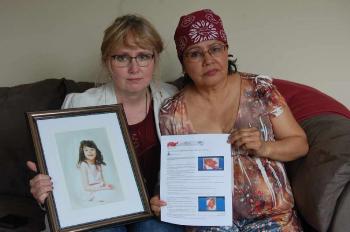Image Caption
By Shari Narine
Windspeaker Contributor
EDMONTON
Four years ago today May 4, Cree Kohkom Kathy’s daughter received a phone call that a taxi cab was on its way to pick her up and take her to an Edmonton hospital because her baby girl had been admitted.
“I knew in my heart that it was something tragic,” said Kathy.
Three weeks after going into government care, Kathy’s granddaughter Dani Isabella Catherine Jean was dead. She was six weeks old.
A month later, Kathy’s younger daughter received word that she and her husband had been approved for kinship care for Dani.
Kathy does not hold Dani’s foster parents accountable for what happened. Although Dani’s death was officially declared “undetermined,” it is likely she died due to sudden infant death syndrome. Kathy says the foster parents were good people and had been “devastated” by Dani’s death.
Kathy holds the Alberta government and the child welfare system accountable.
The faults are many, she says, ranging from her daughter being told Dani wouldn’t be taken into care and then having Dani apprehended to Kathy’s youngest daughter’s kinship care status delayed to the point that it no longer mattered.
And even after Dani died, her birth mother wasn’t officially told the cause. Now, they are awaiting the report from the Public Fatality Inquiry, held in late 2016.
For decades, Kathy had been advocating for Indigenous families, who found themselves broken apart by the system. But in 2013, it became all too real.
“I never thought it would be this personal,” she said. “After Dani’s passing, I found it made me stronger, more vocal, more determined.”
That tragedy and Kathy’s grief forged a bond with Velvet Martin, a mother impacted terribly by the system and who lost her child in 2006.
“(Velvet) is not just a part of my support system. When the grief is so overwhelming, thinking of Dani, we message each other back and forth, just talk. We have a deep connection,” said Kathy.
The two met at a rally in 2009 hosted by the Creating Hope Society, which advocates for children who were in government care, including Sixties Scoop survivors.
Like Kathy, Martin is an advocate for change in the system. But unlike Kathy, Martin’s involvement started with her daughter and escalated to a court case which saw Martin able to name her child.
“I hadn’t been aware of anything being wrong before,” said Martin. “I saw the child welfare system through rose-colored glasses.”
When Martin’s daughter Samantha was born June 4, 1993, she was diagnosed with Tetrasomy 18p, a rare chromosome syndrome. Martin says she and her husband, who is Métis from Ontario, were persuaded by social workers and hospital staff that Samantha would receive the best programs and services if she were put into government care.
The Martins signed a voluntary permanent guardianship order. What ensued, says Martin, was years of abuse, neglect and lack of visits from social workers. Samantha was finally returned home, but died at the age of 13, after spending most of her life in foster care. Because Samantha had been in government care, she could not be named. It was a publicity ban that did not sit well with Martin and she fought it in court, eventually winning, allowing her to name her daughter.
“We have to keep saying their names,” said Martin.
When Dani died, the government had made changes permitting parents to name their children. But since then, the naming of children who have died in government care, has come under question. The most recently-appointed government panel to examine child welfare services is revisiting the issue of naming children.
“Our culture, our tradition saying Dani’s name, helps her spirit. She’s real. She’s still real,” said Kathy. “Dani’s still alive for us.”

